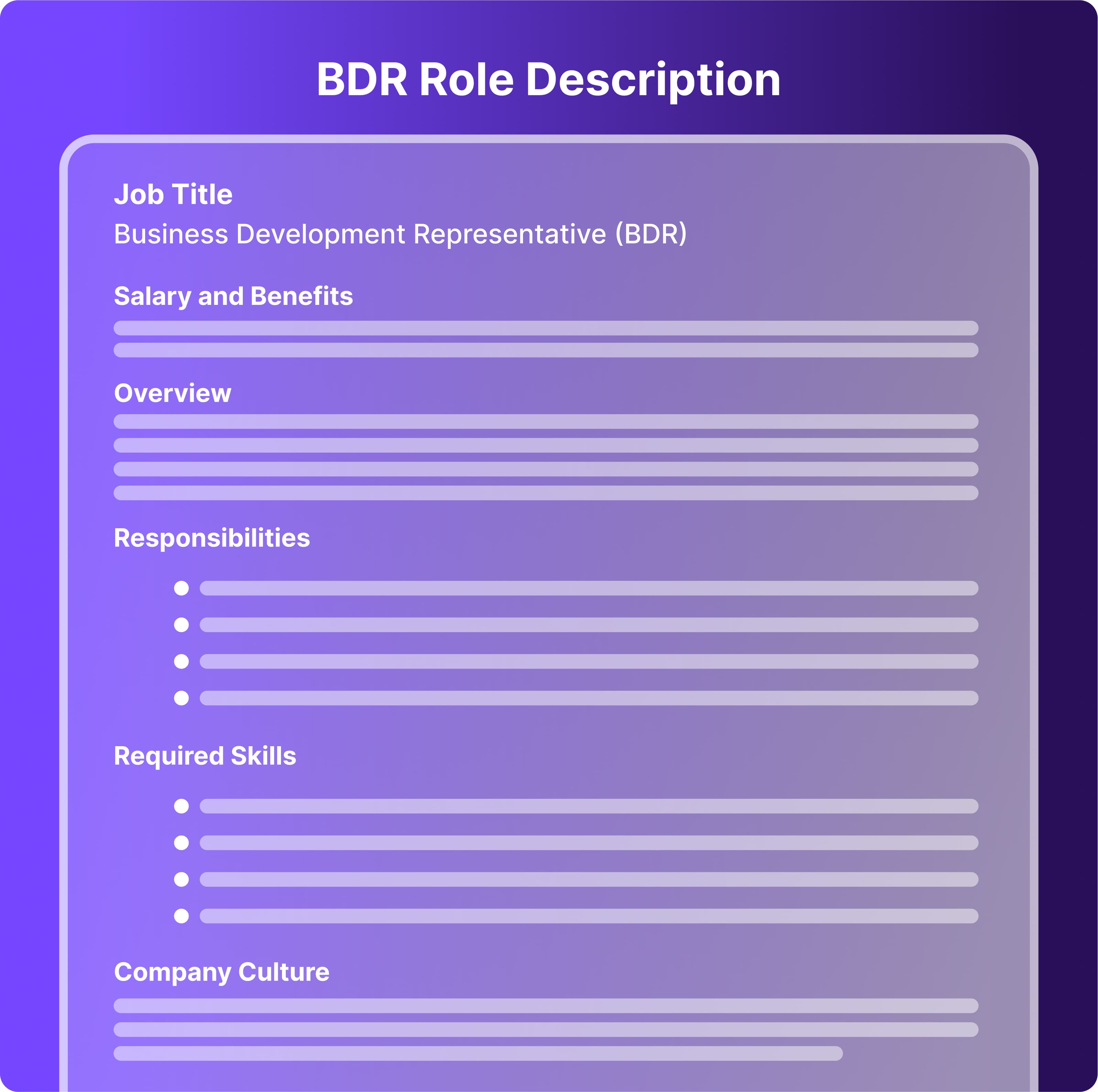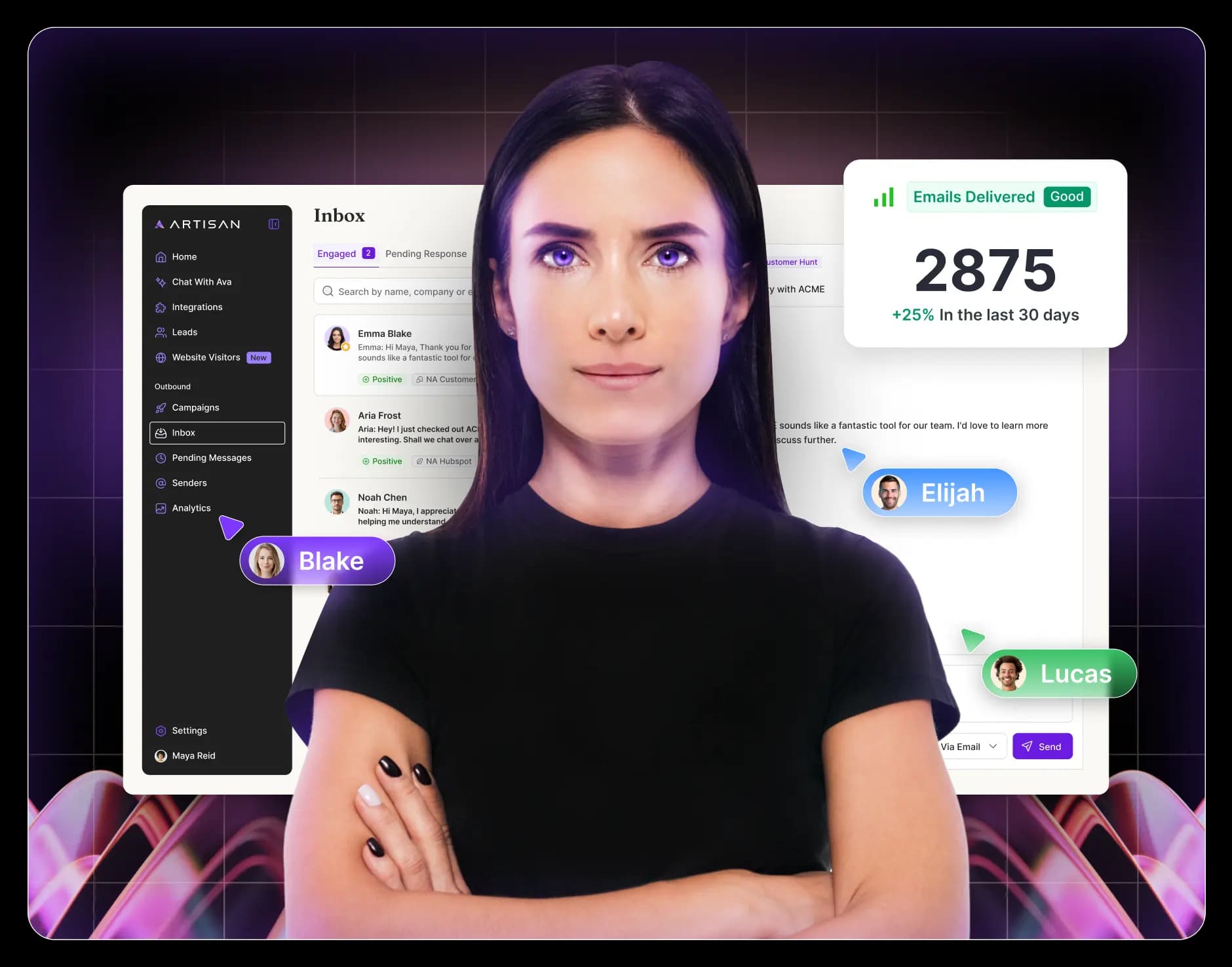Every business needs someone to serve on the frontlines of sales–someone who can do research, build relationships, and plug into the needs of its market. This person is the Business Development Representative (BDR).
The BDR expertly wears multiple hats to spearhead outbound marketing, industry research, lead qualification, and orchestration across an organization's sales and marketing functions.
In this article, we’re breaking down the role of the BDR–what they do, how they do it, and the skills and expertise they need to be successful. Learn what it means to be a BDR, how to seek a top-notch BDR for your organization, and why AI agents like Ava might soon take over major parts of your BDR’s portfolio.
What is a Business Development Representative (BDR)?
A Business Development Representative focuses on identifying and connecting with potential clients for their business. That means they handle many of your outreach efforts: researching, prospecting, engaging leads through different sales techniques, and qualifying these leads for the sales team.
Because a BDR’s responsibilities involve a lot of prospect engagement, they often serve as the primary point of contact between potential customers and a business–the face of the organization.
Their basic responsibilities include:
Researching prospects based on Ideal Customer Profiles (ICPs) using tools like CRMs, ERPs, or advanced database research tools like AI and automation.
Qualifying leads before they enter the sales pipeline using internal metrics and criteria.
Developing ongoing outreach and engagement practices through social media, email, and direct calling.
The Difference Between BDR and SDR
Depending on who you talk to, people may use terms like Business Development Representative and Sales Development Representative (SDR) interchangeably. This is clearly a mistake based on a misunderstanding of the sales process.
Think of the BDR as the face of the company for sales and the SDR as the gatekeeper funneling incoming leads to the right people on your team.

A BDR will focus primarily on outbound lead generation. According to 6sense, 85% of BDRs will work exclusively on outbound sales. In terms of sales, outbound focuses on active prospecting through social media, phone calls, or emails with a deep understanding of your target market. These individuals may spend time researching new markets and expanding their potential business.
An SDR may focus more on inbound leads and qualification. For example, suppose someone lands on your landing page through a marketing campaign and provides their email to access content. In that case, an SDR will qualify the lead and funnel it to a dedicated sales rep or contact them directly.
However, the BDR and the SDR aren’t typically involved in strategy. That’s why they usually work under a Business Development Manager (BDM) who builds more comprehensive sales strategies than the BDR implements.
What Does a Business Development Representative Do?
The better question might be: what don’t BDRs do? They are responsible for the quantifiable (research, lead qualification) and the personal (messaging, conversations, pitches). In this way, they are kind of a jack-of-all-trades within their sales niche.
Some of their more important roles include:
1. Lead Generation and Prospecting
BDRs are often your organization's lead-generation professionals. They identify new businesses and pursue them through outbound channels. This includes performing in-depth market research, managing lists of suitable B2B customers, and persistently engaging leads.
BDRs are also often closest to your ICP and qualifying criteria and are critical in shaping your sales strategies “on the ground.” This skill involves a deep understanding of customer needs and market trends.
Because this work often relies on data analysis, AI tools like Artisan’s AI BDR Ava can fill this function more efficiently than humans. Ava automates outbound sales, personalizes direct sales messaging, and finds qualified leads through our 300M+ database of B2B contacts.
Can you combine an AI BDR with a robust B2B database and industry-leading sales automation? You can with Ava - try hiring her today.
2. Outreach and Initial Contact
BDRs make the first contact with a prospect. After researching and compiling their list, they build relationships with those prospects using social media (primarily LinkedIn), email, and cold-calling strategies.
As you might imagine, this level of engagement can be challenging–most cold outreach has to overcome the fact that a prospect might not know anything about the BDR or their business. This is why the BDR has to have a solid campaign plan (with effective follow-up) and the charisma necessary to pull it off.
However, the sheer volume of potential leads doesn’t lend itself to manual prospecting, so BDRs often rely on large contact databases and automation tools to help them keep track of contacts, outreach, and follow-ups.
3. Lead Qualification and Nurturing
A BDR should take pride in their leads and will serve as the primary qualifier for their prospects. This will include:
Matching prospects against your ICP during their research and engagement with potential customers.
Opening communication and asking qualifying questions regarding budget, needs, timelines, and stakeholders.
Applying qualification metrics and frameworks like Budget, Authority, Need, and Timeline (BANT) assessments.
Scoring leads based on internal scoring models and prioritizing top-scoring leads who are more likely to convert.
Following up with relevant content, sales materials, or meetings to help nurture qualified prospects into the pipeline.
Nurturing is all about building relationships. According to HubSpot, 82% of salespeople consider relationship-building the most crucial part of their job.

4. Collaboration with Sales and Marketing Teams
A Forrester survey showed that 77% of B2B customers expect a personalized, unified experience from companies they might work with. But the BDR isn’t an island—it relies on its colleagues in sales and marketing to present this experience to potential customers.
But this experience doesn’t just pop up. It takes hard work and lessons learned to tailor marketing and sales outreach in a way that works. Lessons learned by marketers, sales representatives, and content creators should help the BDR and the team better position their pipeline to address unique customers' needs and behaviors.
This collaboration works both ways. BDRs need support from marketing, sales, and leadership to perform. According to the 6sense study, 76% of surveyed BDRs reported feeling supported, and these BDRs hit sales quotas 80% of the time. However, those who did not feel supported only hit quotes 61% - 70% of the time.
5. Sales Pipeline Management
BDRs are like the captain of the ship… only in this case, the vessel is the sales pipeline. The BDR usually adopts this role because they often directly manage sales data in your CRM software and can track leads throughout:
Track leads through the process and manages when and how the sales team engages those leads. This task can also include tracking critical metrics like scheduled meetings, conversions, touchpoints, and other engagements. BDRs often create reports around this data to determine the pipeline's health.
Update lead information as it changes. For example, leads might change email addresses or introduce new decision-makers. It’s up to the BDR to ensure that all information remains accurate and reflects the sales team's progress.
Identify bottlenecks and roadblocks in the pipeline where leads are lost or fall off. In this role, the BDR can take a bird' s-eye view of the pipeline, make suggestions regarding changes and efficiencies to ensure each phase runs smoothly, and move a lead to the next stage.
6. Data Management and Reporting
Data entry is a (unfortunately) critical part of sales, and the BDR will often take the lead in ensuring that data stays accurate, accessible, and up-to-date. It’s not the most entertaining job in the world in the best of times, and nearly impossible in our modern, data-driven industry.
Unfortunately, in some (often too many) cases, this can mean that BDRs end up swamped entering data rather than selling a product. This is why they often turn to automation to handle data entry and report key indicators of success (meetings scheduled, lead tracking, and contacts made).
Don’t wait for a human to ensure your sales data is available and accurate. Trust Ava to handle your lead information management. Try Ava today.
Critical Skills and Qualifications for a BDR
BDRs have a mixed bag of skills that cover the tasks they tackle daily. These skills reflect the interpersonal nature of outbound sales and the modern need for data-driven lead nurturing and prospecting tools.
BDR Hard Skills and Soft Skills
An effective BDR will combine a set of critical hard and soft skills to help them do their job:
Hard Skills
Mastery of CRM systems (Salesforce, HubSpot, etc.).
Mastery of prospecting automation and AI tools like Artisan.
Data analysis, specifically of significant behavioral trends for leads moving through a sales process.
Expertise with social media platforms, communication features, and analytics tools.
Soft Skills
Communication skills, particularly those related to using educating and storytelling to articulate your unique value proposition.
Interpersonal skills like trust-building techniques.
Problem-solving, especially regarding approaching difficult leads or coordinating strategies around different data types.
BDR Requirements
While there isn’t a one-size-fits-all set of requirements for BDRs, most job descriptions will include some standard criteria:
A Bachelor’s degree (or higher) in Marketing, Communication, Sales, or Business Administration.
Relevant work experience in sales, specifically in a position focused on sales outreach or account management. In some cases, applicable experience can substitute for education.
Certifications in specific tools, like HubSpot that demonstrate expertise with data and lead management. Instead of certifications, demonstrated expertise on other technologies or platforms can go a long way.
Strong communication skills, including relationship building and knowing how to approach unknown prospects and turn them into potential leads.
Demonstrated ability to work independently, including time-management and planning skills, strategy-building capabilities, and the ability to research and synthesize information.
Business Development Representative Job Description Template
If you're ready to recruit a BDR, you’ll want a clear, concise, and descriptive advertisement that attracts the right talent and capability. This includes specifying the hard and soft skills expected from a candidate, their responsibilities, and the professional culture they would enter into if hired.

Key Elements to Include
Role Overview: Provide a concise summary of the BDR role within the organization. This should include the main objective of the role, such as generating new business opportunities and supporting the sales team.
Responsibilities and Expectations: Clearly outline the BDR's day-to-day duties, such as lead generation, initial outreach, lead qualification, and collaboration with other teams. Include performance expectations, such as the number of leads generated per month or the percentage of leads converted to sales.
Required Skills and Experience: List the essential qualifications, including hard and soft skills, educational background, and any relevant work experience needed for success in the role.
Company Culture and Values: Highlight how the BDR role aligns with the company’s mission and values. This can help attract candidates who are an excellent cultural fit for the organization.
BDR Role Description Example and Template
Job Title: Business Development Representative (BDR)
Salary and benefits: [Insert salary range and benefits packages]

Overview
The BDR plays a central role in driving sales growth for our company, generating new leads and business opportunities in established and emerging markets. This position will take responsibility for identifying potential clients, making initial contact through effective outbound sales strategies, qualifying leads, and managing sales data throughout the sales pipeline.
Responsibilities
Identify prospects through extensive research and knowledge of our core markets, leveraging internal data.
Initiate content with potential leads using a combination of cold calls, emails, and social media.
Qualifying leads using industry-standard frameworks [include frameworks you use, like BANT and CHAMP] and scoring them based on internal criteria.
Manage leads through the early stages of the sales pipeline.
Maintain accurate records of leads in [Insert CRM Platform].
Collaborate with sales and marketing teams to manage lead handoff and align messaging across channels.
Required Skills
Education: [Include minimum required education]
Experience: [x] years of experience in a sales or account management role.
Strong skills in [communication, interpersonal engagement, or other relevant soft skills]
Proficiency in [CRMs, lead-gen platforms, or other tools]
Previous experience in outbound sales or account management
Company Culture
[Include a mission statement about your company, its values, and what you’re seeking from a team member outside of their skills, i.e., passionate, collaborative, innovative, curious, etc.]
Consider Hiring an AI BDR Instead
As we’ve learned in this article, the responsibilities of a BDR are extensive, requiring both a great communicator and someone with technical skills and attention to detail. That’s a tall order to fill, especially as, per a Salesforce report, 57% of sales leaders report increased competition since 2023. Due to mismanaged data, these demands can lead to inefficiencies, bottlenecks, and missed opportunities.
Instead of relying on an in-house BDR that could make mistakes or even outsourced lead generation, consider hiring Ava, our AI BDR.
Ava handles the complexities of outbound lead generation data entry, personalization, and pipeline management so that you can focus on what’s essential: reaching out to prospects and turning them into leads.
Automate your BDR function and see lead volume and quality results. Try Ava today.
![Understanding the BDR Role Description [+Template]](/_next/image?url=https%3A%2F%2Fimages.ctfassets.net%2Fkyprwggh4muz%2F5ci4UWc0QuRA3kp9USsR8D%2Fc08312e8688485fceb176bec5196f2dd%2FCOVER__13_.webp&w=3840&q=75)
